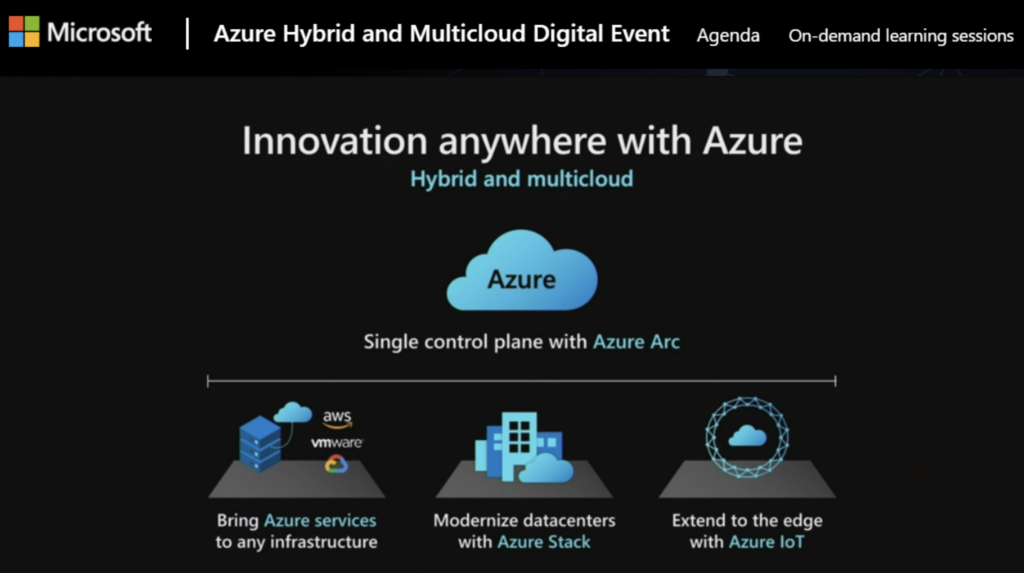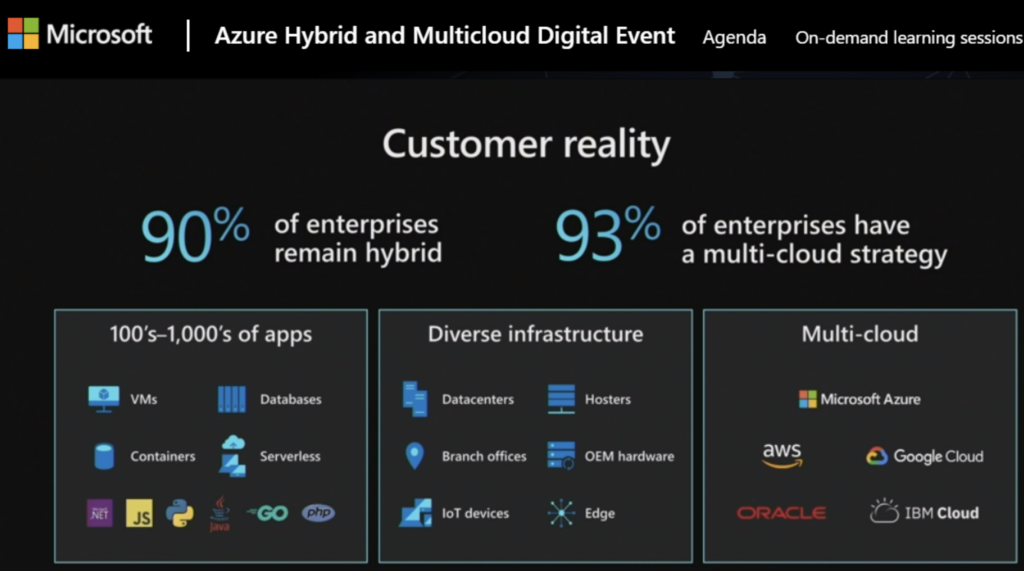M+E Europe

Microsoft Azure Lays Out Its Hybrid and Multi-cloud Vision
Story Highlights
Microsoft Azure used its Azure Hybrid and Multi-cloud Digital Event on June 29 to explain its hybrid and multi-cloud vision and provide details on the latest Azure Arc and Azure Stack hyper-converged infrastructure (HCI) offerings.
“Software and technology are infused in every part of our lives: at home, at work, school, in our cars, in our pockets,” according to Roanne Soanes, corporate vice president of Azure Edge + Platform at Microsoft.
“To meet these growing customer demands and to stay competitive, every company will become a digital company,” she told viewers. “This is happening across every industry with software-powered, digital-born disruptors placing pressures on companies of every size to accelerate their digital transformation.”
 And Microsoft is “here to help,” she said, explaining: “Azure’s mission is to be the world’s computer. As the world’s computer, we want to empower organisations to build and transform from technology on your terms, wherever you are and whatever your need. And we want to make this simple for our customers. In reality, we know our customers’ environments are anything but simple. Customer environments are diverse and complex. Their needs are ever-evolving.”
And Microsoft is “here to help,” she said, explaining: “Azure’s mission is to be the world’s computer. As the world’s computer, we want to empower organisations to build and transform from technology on your terms, wherever you are and whatever your need. And we want to make this simple for our customers. In reality, we know our customers’ environments are anything but simple. Customer environments are diverse and complex. Their needs are ever-evolving.”
About 90% of enterprises depend on a hybrid approach and 93% of enterprises have a multi-cloud strategy, she pointed out.
“A thing that has really resonated when talking to customers is the breadth and diversity of apps and infrastructure,” she said, adding: There are “thousands of apps running in the data centres and a real desire to modernise this with cloud technologies.”
Meanwhile, “multiple teams are using different development tools, languages and frameworks, as well as approaches, like open-source, Kubernetes and DevOps,” she noted. “It leaves customers with open questions on how best to manage, govern and secure this while simultaneously enabling innovation and agility.”
We are now at “peak centralisation with public cloud and we need to move to more ubiquitous and decentralised compute power with decentralised control,” she told viewers. “Regulatory and data sovereignty are top of the list driving these requirements, she said, adding: “This is common in highly regulated industries such as financial services, healthcare and government. Some workloads, especially edge workloads, require low latency, driving a desire to keep compute capabilities close to the workload.”
Also, many companies have “significant on-premises investments that they want to maximise where the cost of the cloud is currently prohibitive,” she pointed out.
Microsoft is also “seeing the cloud business patterns apply to these requirements where customers are looking to move from” capital expenditures to operating expenses with hardware as their service business model, coupled with a managed service offering so the customer has a single vendor to supply, manage, operate and serve as their edge solution,” she told viewers.
From the start, Microsoft has been “designing Azure to meet our customers’ needs, no matter how simple or complex,” she noted.
“The future world will be a hybrid and multi-cloud environment with workloads that span on-premise, Azure and other clouds with a posture and app pattern that is cloud first,” she predicted. “I think about this across a full spectrum, from sensor to server, silicon to service, from what happens in the data centre to what happens in your operations at the edge.”
 And Azure offers “unique hybrid and multi-cloud capabilities that give customers the flexibility to innovate anywhere,” she explained. “It starts with Azure Arc,” which she noted “enables you to standardise visibility, operations and compliance across a wide range of resources and locations by extending the Azure control plane.”
And Azure offers “unique hybrid and multi-cloud capabilities that give customers the flexibility to innovate anywhere,” she explained. “It starts with Azure Arc,” which she noted “enables you to standardise visibility, operations and compliance across a wide range of resources and locations by extending the Azure control plane.”
Enabled by Azure Arc, organisations can “bring Azure surfaces to any infrastructure, including other clouds, so you can take advantage of Azure’s benefits everywhere, such as scalability, fast deployment and always up-to-date cloud innovation,” she told viewers. “You can build Azure-consistent new cloud infrastructure in your own data centre with Azure Stack so you can modernise your data centre and run cloud native applications on premises while taking advantage of existing investments and meeting regulatory requirements.”
Artificial intelligence can also be extended to edge devices with Azure Internet of Things (IoT) “so you can run machine learning and advanced analytics close to the users and the data,” she noted.
She went on to discuss the five steps she said are required to successfully adopt a hybrid and multi-cloud strategy.
Five Steps for Adoption of a Hybrid and Multi-cloud Strategy With Azure
- Unified operations and management with Azure Arc.
- Build cloud native apps and run Azure services anywhere.
- Modernise your data estate with Azure data services.
- Run traditional VM apps and containerised workloads backed by the power of Azure.
- Manage sensor to server IoT devices.
New from Microsoft as part of Azure data services is Azure SQL enabled by Azure Arc, which Soanes said will become generally available July 30.
“This new offering from Azure SQL can run on any Kubernetes in your data centres at the edge and in a multi-cloud environment,” she told viewers. “You’ll get all the Azure innovations on this evergreen SQL that has no end of support and is only available from Azure, plus all the cloud benefits, like elastic scale, built-in automation and a cloud billing model that helps to manage costs efficiently. This truly changes the paradigm on how services for on-premises data workloads are delivered.”
She added that customers “can expect continuous release of new capabilities with Azure SQL so you are always on the cutting edge for all your data footprint across the entire estate.”
Microsoft also unveiled AKS on Azure Stack HCI and Azure Arc-enabled application services at the Microsoft Build developer conference in May, she noted.









